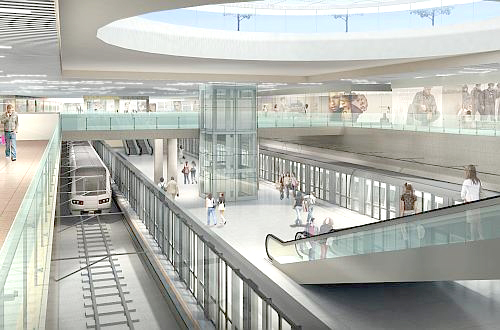 Society
Society

HCM City authorities are developing a plan for design and construction of underground spaces around metro line stations as part of an effort to renovate its inner districts and develop infrastructure in the next five years.

|
| A rendered image of a 45,000-sq.m underground shopping mall under the Bến Thành central station of city’s first metro line. — Photo courtesy of the Management Authority for Urban Railways |
HCM CITY — HCM City authorities are developing a plan for design and construction of underground spaces around metro line stations as part of an effort to renovate its inner districts and develop infrastructure in the next five years.
Lý Khánh Tâm Thảo, head of the city Department of Planning and Architecture’s Technical Infrastructure Management Department, said underground development is an important part of the city’s 2025 master plan adjustments.
“The city wants to create an underground space full of state-of-the-art public facilities to best serve its citizens,” he added.
Development of underground spaces will focus initially on the city’s central area, covering 930ha in districts 1 and 3, Bình Thạnh District, and a part of District 4.
Underground areas, especially near metro stations and the Bến Thành Central Station, will be built and developed into commercial centres over a period of years, even after the metro lines are opened.
The 20km metro line No.1 will extend from Bến Thành Market in central District 1 to Suối Tiên Theme Park in District 9. It is expected to be operational in late 2021. The line runs through districts 1, 2, 9, Bình Thạnh and Thủ Đức, and neighbouring Bình Dương Province.
Museums and other cultural spaces, as well as other works such as drainage and flood prevention projects, will also be built in underground spaces, according to Thảo.
The city has also planned for underground parking spaces, but nothing has been put into use yet.
Delayed underground complex
The Bến Thành underground trade complex, however, is likely to be delayed because it has not attracted investors, according to the Department of Planning and Investment.
The department said the VNĐ6.8 trillion ($293.49 million) construction would not be done together with the first Bến Thành underground station of first metro line. As a result, the ground would have to be dug twice, possibly affecting the metro’s operation.
Approved in 2016, the underground complex was originally scheduled to be finished at the same time as the first metro line in 2021.
The city has assigned the Management Authority for Urban Railways to draw up a plan to execute the underground complex. It has also organised an international contest to choose the best designs for the complex.
The Bến Thành Central Station will be the hub of the city’s metro lines, where they will converge. The connections between the underground complex and the metro line will allow residents to enjoy both facilities in the same space.
The underground complex would be built on an area of 45,000 sq.m, starting from the Bến Thành Central Station to the city’s Opera House. The commercial section would make up 18,000 sq.m, while the remaining space woukd be reserved for underground hallways and a public square.
Recommendations
Experts have recommended the city seek advice from foreign consultants on ideas for planning, spatial design, and management regulations for the underground complex at the Bến Thành Central Station.
The Department of Planning and Architecture will organise a forum to discuss the development of the underground space with experts, residents and businesses.
Hoàng Tùng, deputy director of the Department of Planning and Architecture, said that underground work would need a huge amount of investment and time, affecting water resources and the environment.
The plan must ensure an efficient use of land as well as compatible connections with existing structures on the ground, he said, adding that it must also meet the requirements of underground water, security and defense.
Dr. Võ Kim Cương, former director of the Department of Planning and Architecture, said the core issue involved in the underground project would be the locations of the construction work, which will depend on factors like geology and water resources.
Geological and hydrological surveys and assessments, therefore, must be carried out first.
Hà Ngọc Trường, vice chairman of the HCM City Road, Bridge and Port Association, a consultant for the city’s two metro lines, said most of the stations would be underground on the first metro line.
The scope of the research for underground planning, therefore, should not be limited to the downtown area and Thủ Thiêm new urban area, but should also be based on metro stations in other districts as well, he said. — VNS




